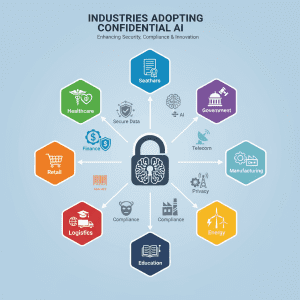Introduction
In today’s hyper-connected digital era, businesses face a relentless wave of cyber threats that can disrupt operations, damage reputation, and erode customer trust. Traditional cybersecurity practices are increasingly insufficient to keep pace with the rapid evolution of these cyberattacks. Enter the Digital Immune System (DIS), a revolutionary approach that mimics the human immune system to protect, detect, and respond to cyber threats proactively and intelligently.
This blog will explore how a Digital Immune System works, the critical benefits it brings, and why modern businesses must adopt this next-generation cybersecurity framework to safeguard their digital ecosystems effectively.
What Is a Digital Immune System?
A Digital Immune System is an integrated set of automated cyber defense mechanisms and analytical tools designed to detect anomalies, neutralize threats, and ensure operational continuity with minimal manual intervention. Like the biological immune system that protects organisms from diseases, DIS protects digital assets—from software applications to network infrastructure—against a broad spectrum of cyberattacks.
It combines advanced cybersecurity components such as firewalls, intrusion detection and prevention systems (IDPS), antivirus software, multi-factor authentication (MFA), AI-driven monitoring, and automated incident response in a continuous protective feedback loop.
By leveraging AI, machine learning, and predictive analytics, the system actively learns from evolving threats and adapts, providing a dynamic and resilient cybersecurity posture that traditional static defenses cannot match.
Why Your Business Needs a Digital Immune System
Evolving Cyber Threats Demand Proactive Defense
The cyber threat landscape is becoming more sophisticated with ransomware, phishing, supply chain attacks, and advanced persistent threats (APTs) aiming to penetrate networks undetected. According to Cisco’s 2024 Cyber Threat Trends report, malware such as Trojans and ransomware continue to rise exponentially.
Traditional reactive cybersecurity, which waits for threats to emerge before responding, often results in costly downtimes and data breaches. A Digital Immune System helps businesses stay ahead by continuously monitoring and neutralizing risks in real-time.
Enhanced Protection with AI and Automation
DIS uses AI to automate threat detection and response, minimizing human error and reaction time. It can identify unusual user behavior or anomalous data flows instantly and trigger automated containment procedures. This proactive approach reduces potential damage and ensures business continuity.
Improved User Experience and Operational Resilience
With observability and auto-remediation functionalities, Digital Immune Systems maintain smooth and uninterrupted digital operations, significantly improving user experience. It identifies vulnerabilities before exploitation and rapidly recovers systems in case of disruptions.
Regulatory Compliance and Data Security
Adopting a Digital Immune System helps businesses ensure compliance with stringent data protection laws and cybersecurity standards. Continuous monitoring and detailed analytics generate reports required for audits and regulatory assessments.
Core Components of a Digital Immune System
-
Firewalls
Act as the first defense line, filtering inbound and outbound traffic based on security policies to block unauthorized access. -
Intrusion Detection and Prevention Systems (IDPS)
Monitor network activity for suspicious behavior and known attack signatures, blocking threats before they spread. -
Antivirus and Anti-Malware Software
Scan, identify, and eliminate malicious software including viruses, spyware, and ransomware. -
Multi-Factor Authentication (MFA)
Strengthens access controls by requiring multiple authentication methods, reducing the risk of compromised credentials. -
AI-driven Threat Monitoring and Analytics
Continuously analyze system and user behaviors using machine learning algorithms to detect anomalies and evolving attack patterns. -
Automated Incident Response and Recovery
Integrates with orchestration tools to quickly isolate affected components, mitigate attack impact, and restore normal operations. -
Chaos Engineering and Vulnerability Testing
Proactively stress-test systems by simulating failures, helping identify and repair weaknesses before attackers exploit them.
How a Digital Immune System Works to Shield Your Business
A Digital Immune System continuously observes network and application environments to detect deviations from normal activity that could signal cyberattacks. When an anomaly or threat is detected, it quickly initiates containment measures, such as isolating infected systems, blocking attack vectors, or prompting additional authentication measures.
The system utilizes threat intelligence feeds to stay abreast of newly emerging threats globally and incorporates this knowledge proactively to shield the business.
With continuous learning, the immune system improves its detection accuracy, reducing false positives and focusing security efforts efficiently.
Benefits of Implementing a Digital Immune System
| Benefit | Description |
|---|---|
| Robust Security | Provides comprehensive defense against an evolving range of cyber threats, dramatically reducing vulnerabilities. |
| Reduced Downtime | Automated detection and remediation minimize system downtime, helping maintain business continuity and customer satisfaction. |
| Enhanced Compliance | Supports adherence to data privacy regulations and cybersecurity standards with detailed monitoring and reporting capabilities. |
| Scalability and Adaptability | Adapts to changing IT environments, including cloud, IoT, and hybrid infrastructure, scaling security measures accordingly. |
| Cost Efficiency | Reduces the need for constant manual monitoring and intervention, cutting operational security costs. |
Implementing a Digital Immune System: Best Practices
-
Assess Your Current Security Posture
Conduct a thorough risk and vulnerability assessment to identify gaps in your cybersecurity defenses. -
Integrate Advanced Technologies
Invest in AI, machine learning, and automation platforms that support continuous threat detection and response. -
Embed Security Early in Development (DevSecOps)
Incorporate security processes throughout the software lifecycle to minimize vulnerabilities. -
Focus on Observability and Monitoring
Implement real-time monitoring tools that provide visibility into system health and user behavior. -
Adopt a Layered Security Model
Combine traditional security elements with proactive immune system components for a defense-in-depth strategy. -
Train Your Team
Educate employees about cybersecurity risks and their role in maintaining a strong digital immune system. -
Partner with Experts
Work with cybersecurity providers to design, deploy, and continuously improve your digital immune capabilities.
Real-World Applications and TechOTD Solutions
Leading businesses worldwide leverage Digital Immune Systems to ensure resilience and agility in cybersecurity. At TechOTD, we specialize in developing AI-driven cybersecurity solutions tailored for your business needs. Our services from AI-powered analytics and automation to seamless integration of blockchain for secure business processes (blockchain use cases) provide cutting-edge protection frameworks.
Discover how our strategic approach and collaboration model (How We Work) can transform your cybersecurity posture and business operations. Explore our insights on related technology trends and tools through TechOTD blogs, including deep dives into AI, blockchain, mobile app security, and predictive analytics.
Frequently Asked Questions (FAQ)
Q1: What distinguishes a Digital Immune System from traditional cybersecurity?
A Digital Immune System combines automation, AI, and continuous learning to proactively detect and respond to threats in real-time, unlike traditional systems that often rely on manual intervention and static defenses.
Q2: Can Digital Immune Systems protect against zero-day attacks?
Yes, by analyzing behavioral anomalies and integrating global threat intelligence, Digital Immune Systems can identify and mitigate zero-day vulnerabilities and unknown threats swiftly.
Q3: How does AI enhance a Digital Immune System?
AI enables predictive analytics, anomaly detection, and automated responses, reducing human error and speeding up threat containment.
Q4: Is implementing a Digital Immune System expensive for small businesses?
Technological advances and cloud-based solutions have made DIS scalable and affordable for businesses of all sizes, offering customizable deployment options.
Q5: How does TechOTD support businesses in building Digital Immune Systems?
TechOTD delivers tailored AI-powered cybersecurity services, custom model development, and integration support to build resilient digital immune defenses aligned with business goals (TechOTD AI services).
Conclusion
As cyber threats become more frequent and intricate, building a Digital Immune System is essential for ensuring business resilience, security, and compliance. By continuously monitoring, learning, and adapting, this immune system empowers businesses to fend off cyberattacks, minimize downtime, and maintain customer trust.
Harness the power of AI and automation with expert partners like TechOTD to implement a robust Digital Immune System that future-proofs your operations in an increasingly hostile cyber environment.











